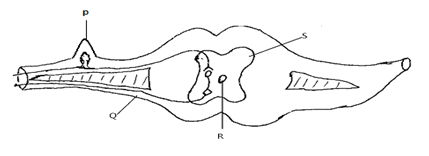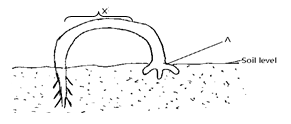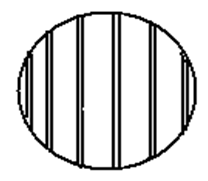Instructions to candidates
- Answer all questions in this question paper.
- Answers to all questions must be written in the spaces provided in this booklet.
- This paper consists of eight printed pages. Candidates should check to ascertain that all pages are printed as indicated and that no questions are missing.
- Name the organelles that would be most likely found in large numbers in cells that perform the functions below. (2mks)
- A cell in the ileum that actively takes in glucose.
- A cell in the liver that breaks down foreign bodies.
- A doctor added a few drops of anti B-serum to two samples of blood in a blood test. No agglutination occurred. Name the blood groups of the blood samples. (2mks)
- State the significance of metamorphosis in insects. (3mks)
- State three structural differences between muscles alimentary canal and biceps muscles. (3mks)
- The dental formula of a certain animal is
- Suggest the mode of feeding of the animal (1mk)
- Give a reason for your answer in part (i) above (1mk)
- In an accident a victim suffered damage of his internal organs, consequently he started having excess glucose in his blood.
- Which organ was damaged? (1mk)
- Give a reason for your answer (1mk)
- Name two structures in plants where meiosis occurs (2mks)
- The diagram below represents a reflex arc in human
- Name the parts labelled P and S (2mks)
- State the function of the parts labelled Q (1mk)
- Part R contains some type of fluid. Name the fluid. (1mk)
- State three roles of diffusion in plants (3mks)
- During the first phase of respiration, a glucose molecule is broken down into pyruvic acid and a small amount of energy is produced.
- Name the process described above. (1mk)
- State where the process you have name in (a) above takes place in a cell. (1mk)
- The energy used by a hawk for flying is obtained indirectly from the sun. Explain. (3mks)
- The flippers of whales and fins of the fish adapt these organisms to aquatic habitats.
- Name the evolutionary process that may have given rise to such structures. (1mk)
- What name is given to such structures? (1mk)
- In an experiment to investigate an aspect of digestion, two test tubes A and B were set up as shown in the diagram below The test tubes were left in the water bath for 30 minutes. The content of each test tube was then tested for starch using iodine solution.
- What was the aim of the experiment? (1mk)
- What results were expected in test tubes A and B (2mks)
- Why was the set-up maintained at 370C. (1mk)
- Explain how drooping of leaves in a hot sunny day is advantageous to a plant. (2mks)
- State two classes of the phylum arthropoda in which the body is divided into cephalothorax and abdomen. (2mks)
- What is co-dominance? (1mk)
- Name two disorders in human blood that are caused by gene mutation. (2mks)
- Describe what happens during the dark stage of photosynthesis (3mks)
- The diagram below represents a structure found in plants.
- Name the parts labelled P and R (2mks)
- State how part Q is adapted to its function (2mks)
- A certain species of flowering plant relies entirely on sexual reproduction for propagation. The chromosome number of the cell in the ovarian wall is 16. State the chromosome number of
- The pollen tube nucleus (1mk)
- A cell of the endosperm (1mk)
- The diagram below represents germination of a certain seed.
- Name the type of germination exhibited by the seedling above (1mk)
- Name the region labeled X (1mk)
- Explain how the part labeled X of the seedling straightens after exposure to sunlight. (3mks)
- A student estimating the cell size of an onion epidermal cell observed the following on the microscope field of view using a transparent ruler. The student counted 20 cells a cross the field of view.Calculate the size of the cell in micrometer. Show the working clearly. (3mks)
- Name the components of the blood that do not enter the renal tubule in mammals. (2mks)
- Give three reasons as to why biological control is preferred to chemical control in the control of pests and parasites. (3mks)
- A person fell from the third floor of a storey building and had part of his brain damaged. Indicate the part of the brain damaged if the person suffers from the following.
- Loss of memory and speech (1mk)
- Inability to regulate body temperature (1mk)
- Irregular heartbeat and breathing (1mk)
- Inability to maintain proper body balance and posture (1mk)
- Name the microorganism found in the root nodules of legumes (1mk)
- State the association of the micro-organisms named in (a) above (1mk)
- What is the role of the microorganism you named in (a) above. (1mk)
- Name the causative agent of cholera (1mk)
- State two ways in which the composition of blood in the umbilical artery differ from that in umbilical vein (2mks)
- State three ways in which the tracheole system is adapted to its function. (3mks)
- Give a reason for each of the following.
- Long feathery stigma in a flower (1mk)
- Presence of nectaries in some flowers (1mk)
- For a leaf to be efficient for photosynthesis, it has to be broad and thin. Explain. (2mks)

MARKING SCHEME
-
- Mitochondria / Mitochondrion;
- Lysosome / Lysosomes;
- O; A;
- Ensures no competition; for dispersal; survival; eg pupa stage
- Biceps muscles alimentary canal muscles
- Has striations /striped - Lacks striations /stripes structures
- Has long cylindrical fibres - Spindle shaped fibres
- Multinucleated - Uninucleated;
-
- Herbivorous;
- Has no upper incisors and canines;
-
- Pancrease;
- No production of insulin hence no regulation of blood sugar /glucose in blood.
- Anther(s);Ovaries/Ovary;
-
- P - Ganglion;
S – Grey matter; - Transmits the nerve impulse from CNS (relay) to the effector;
- Cerebrospinal fluid;
- P - Ganglion;
- Absorption of mineral salts from the soil (through the root hairs); Exchange of gases in stomata; translocation / transport of food substances in green plants;
-
- Glycolysis;
- Cytoplasm;
- Green plants use energy from the sun to manufacture food ( photosynthesis); the plants are eaten by small herbivorous animals such as mice, rats, moles etc; the hawk feed on these small herbivores and use part of the food in respiration to release energy for flying;
-
- Convergent evolution;
- Analogous structure;
-
- Effect of temperature on enzyme activity;
- A- No observable colour change / colour of iodine (brown) remains /remains Brown;
B-Blue black/black colour; - Provide optimum temperature for enzymatic action;
- Leaves expose smaller surface area to the sun; thus reducing excessive water loss by transpiration;
- Arachnida; Crustacea;
-
- Where both alleles express themselves equally / none is dominant over the other / None is recessive over the other;
- Sickle cell anaemia ; Haemophilia;
- Carbon (IV) oxide combines with hydrogen atom; using ATP energy; to form simple sugars / glucose; Rej hydrogen gas
-
- P - Epidermal cell;
R = Stoma / stomatal pore; - Has thick inner wall and thin outer walls to control opening and closing of Stoma;
Has chloroplasts to carry out photosynthesis / manufacture of glucose that alter osmotic pressure bringing about opening and closing of stomata;
- P - Epidermal cell;
-
- 8;
- 24;
-
- Epigeal;
- Hypocotyl;
- Light causes downward migration of auxins to the darker side of the seedling; This causes high concentration of auxins / accumulation of auxins to the lower side of seedling causing faster growth in the darker side ;than the lit side; hence the seedling straightens upwards towards light;
-
- Blood cells; plasma proteins;
- -No poisonous substances used;
-No accumulation along food chains;
-No resistance can be developed;
-No residual effects / no non-biodegradable substances in the environment;
Mark 1st three(3)
-
- Cerebrum;
- Hypothalamus;
- Medulla oblongata;
- Cerebellum;
-
- Rhizobium;/nitrogen -fixing bacteria;
- Symbiosis;/symbiotic/mutual;
- Nitrogen fixation/converts for nitrogen into nitrates;
- Vibrio cholerae; rej if not underlined separately
- Umbilical artery Umbilical vein
- rich /more waste products Poor in /less waste products/
more CO2 and urea less CO2 and area; - Poor in oxygen /and nutrients Rich in oxygen / and nutrients
(glucose /amino acids) (glucose /amino acids);
- rich /more waste products Poor in /less waste products/
- Moist to dissolve respiratory gases; Thin walled to reduce the distance for diffusion; Highly branched to increase surface area for gaseous exchange; Have rigid cuticle to avoid collapsing of tracheoles hence remain open
-
- To enable it to trap pollen grains from the air;
- To produce nectar; reject – attract insects
- capture /catch pollen grains
- Broad to increase surface area; for maximum absorption of CO2 and light penetration;
Join our whatsapp group for latest updates
Tap Here to Download for 50/-
Get on WhatsApp for 50/-
Download BIOLOGY PAPER 1 - 2019 KCSE KASSU JOINT MOCK EXAMS (QUESTIONS AND ANSWERS).
Tap Here to Download for 50/-
Get on WhatsApp for 50/-
Why download?
- ✔ To read offline at any time.
- ✔ To Print at your convenience
- ✔ Share Easily with Friends / Students







